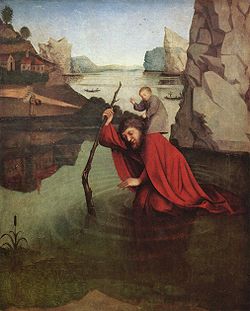
Konrad Witz
Encyclopedia

Konrad Witz - c. Winter 1445/Spring 1446 in Basel, Switzerland
Switzerland
Switzerland name of one of the Swiss cantons. ; ; ; or ), in its full name the Swiss Confederation , is a federal republic consisting of 26 cantons, with Bern as the seat of the federal authorities. The country is situated in Western Europe,Or Central Europe depending on the definition....
) was a German painter, active mainly in Basel, Switzerland.
Witz is most famous for painting three altarpieces, all of which survive only partially. The earliest is the Heilspiegel Altarpiece of about 1435 (today mostly in the Kunstmuseum, Basel, with isolated panels in other collections). The next is the Altarpiece of the Virgin (c. 1440), which has been associated with panels now in Basel, Nuremberg, and Strasbourg (Musée de l’Œuvre Notre-Dame
Musée de l’Œuvre Notre-Dame
The Musée de l’Œuvre Notre-Dame is the city of Strasbourg's museum for Upper Rhenish fine and decorative arts from the early Middle Ages until 1681...
). Witz's final altarpiece is the St. Peter Altarpiece of 1444, painted for St. Peter's Cathedral
St. Pierre Cathedral
The St. Pierre Cathedral is a cathedral in Geneva, Switzerland, today belonging to the Swiss Reformed Church. It was begun under Arducius de Faucigny, the prince-bishop of the Diocese of Geneva, in the 12th century, and includes an eclectic mix of styles. It is best known as the adopted home church...
, Geneva
Geneva
Geneva In the national languages of Switzerland the city is known as Genf , Ginevra and Genevra is the second-most-populous city in Switzerland and is the most populous city of Romandie, the French-speaking part of Switzerland...
, and now in the Musée d'Art et d'Histoire
Musée d'Art et d'Histoire (Geneva)
The Musée d’Art et d’Histoire is the largest art museum in Geneva, Switzerland.-The building:The museum is located in Les Tranchées, in the city centre, on the site of the former fortification ring. It was built by the architect Marc Camoletti between 1903 and 1910, and financed by a bequest from...
, Geneva, which contains his most famous composition, the Miraculous Draught of Fishes.
The painting of St. Christopher (Kunstmuseum, Basel; illustrated) does not seem to be related to these major altarpieces. Other independent works by Witz and his followers can be found in Naples, Berlin, and New York (Frick Collection).
Literature
- Bodo Brinkmann: Konrad Witz (anlässlich der Ausstellung Konrad Witz, Kunstmuseum Basel, 6. März - 3. Juli 2011). Stuttgart, Hatje, 2011. ISBN 978-3-7757-2760-0.
- Karin Althaus: Konrad Witz. Ein Pionier der Malerei im 15. Jahrhundert. Königstein i. Ts., Langewiesche, 2011. ISBN 978-3-7845-1901-2
- Dorothee Eggenberger: Die Basler Heilspiegelbilder. Ein Auftragswerk von König René d'Anjou und Kardinallegat Giuliano Cesarini? In: Zeitschrift für Schweizerische Archäologie und Kunstgeschichte 67, 2010, S. 83-112.
- Françoise Rücklin: Konrad Witz et ses commanditaires français. In: Zeitschrift für schweizerische Archäologie und Kunstgeschichte 57 (2000), S. 105–130
- Sabine Brandt: Der Basler Altar des Konrad Witz. Forschungsstand und Forschungsfragen. Hamburg, Univ., FB Kulturgeschichte, Mag.-Schr., 1991
- Stefan Achternkamp: Konrad Witz und das Konzil von Basel. Stuttgart, Univ., Magisterarbeit, 1989
- Hans J. van Miegroet: De invloed van de vroege Nederlandse schilderkunst in de eerste helft van de 15de eeuw of Konrad Witz. Brussel, AWLSK, 1986.
- Charles Sterling: L' influence de Konrad Witz en Savoie. In: Revue de l'art, Paris, Ed. du Centre national de la Recherche Scientifique, 1986
- Florens Deuchler: Konrad Witz, la Savoie et l'Italie. Nouvelles hypothéses à propos du retable de Genève. In: Revue de l'art 71, S. 7–16. Paris, Ed. du Centre national de la Recherche Scientifique, 1986
- Marianne Barrucand: Le retable du miroir du salut dans l'oeuvre de Konrad Witz. Genève, Droz, 1972. Travaux d'humanisme et renaissance, 124
- Uta Feldges-Henning: Werkstatt und Nachfolge des Konrad Witz, ein Beitrag zur Geschichte der Basler Malerei des 15. Jahrhunderts. Basel, Univ., Diss., 1967
- Herwarth Röttgen: Zwei noch umstrittene Zuschreibungen an Konrad Witz. In: Jahrbuch der Berliner Museen NF III, 1961, S. 76 ff.
- Alfred Stange: Ein Madonnenbild von Konrad Witz. In: Pantheon XIX, 1961, S. 39.
- Emil Maurer: Konrad Witz und die niederländische Malerei. In: Zeitschrift für Schweizerische Archäologie und Kunstgeschichte XVIII, 1958, S. 158 ff.
- Georg Schmidt: Der Maler Konrad Witz. In Merian IX, 1956, H. 7, S. 42 ff.
- Georg Schmidt: Konrad Witz. Königstein i. Ts., Langewiesche, 1962
- Gustav Friedrich Hartlaub: Der Saturn bei Witz. In: Genava NF III, 1955, S. 141 ff. Genève, Musée, 1955
- Paul Leonhard Ganz: Meister Konrad Witz von Rottweil. Bern-Olten, Graf, 1947
- Joseph Gantner: Konrad Witz. Wien, Schmoll, 1942
- Hans Wendland: Konrad Witz. Gemäldestudien. Basel, Schwabe, 1924
- Paul Ganz: Ausstellung der Genfer Altarflügel des Konrad Witz in der Öffentlichen Kunstsammlung in Basel. Basel, Birkhäuser, 1917
- Mela Escherich: Konrad Witz. Straßburg, Heitz, 1916. Studien zur deutschen Kunstgeschichte 183.

